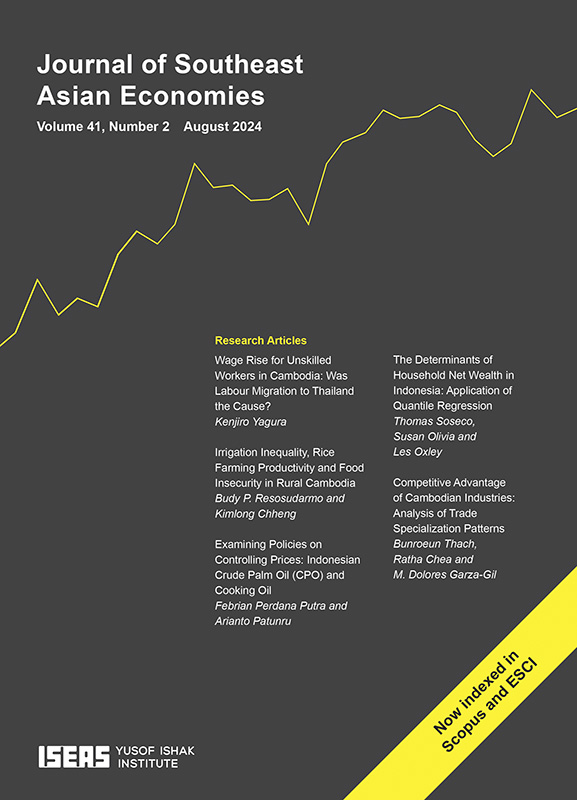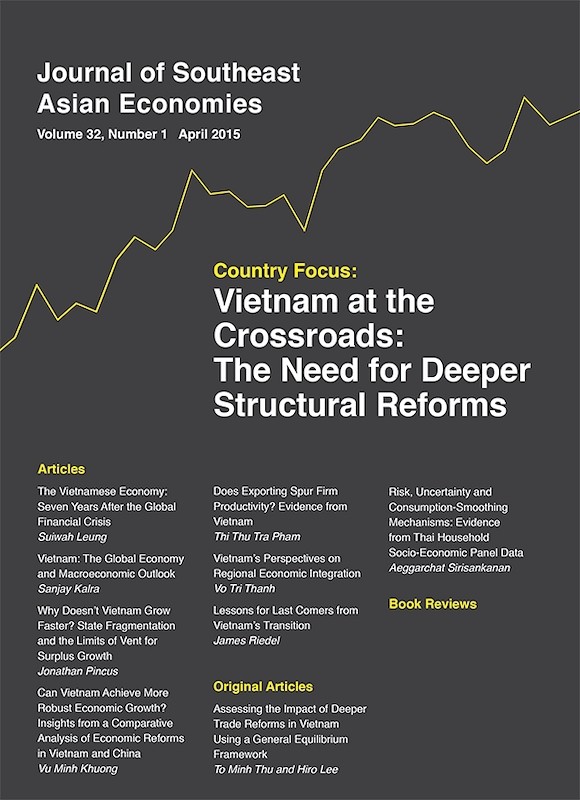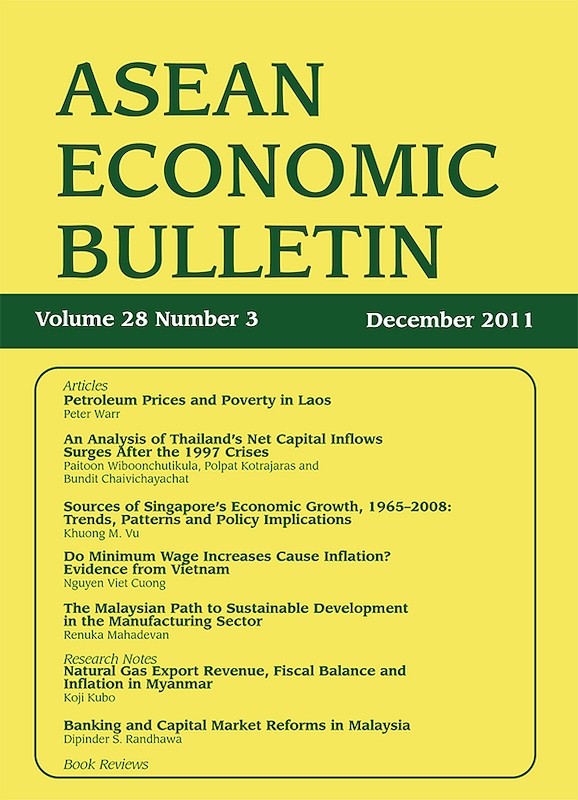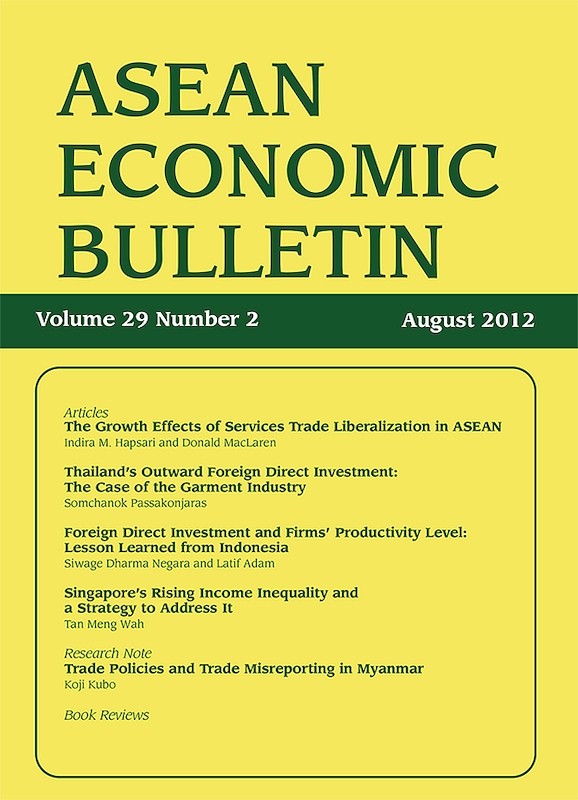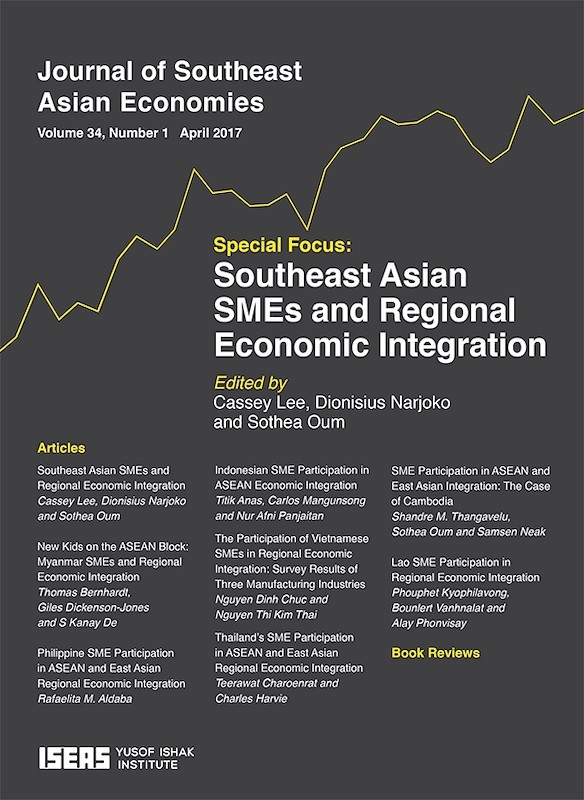ASEAN Economic Bulletin Vol. 27/2 (Aug 2010)
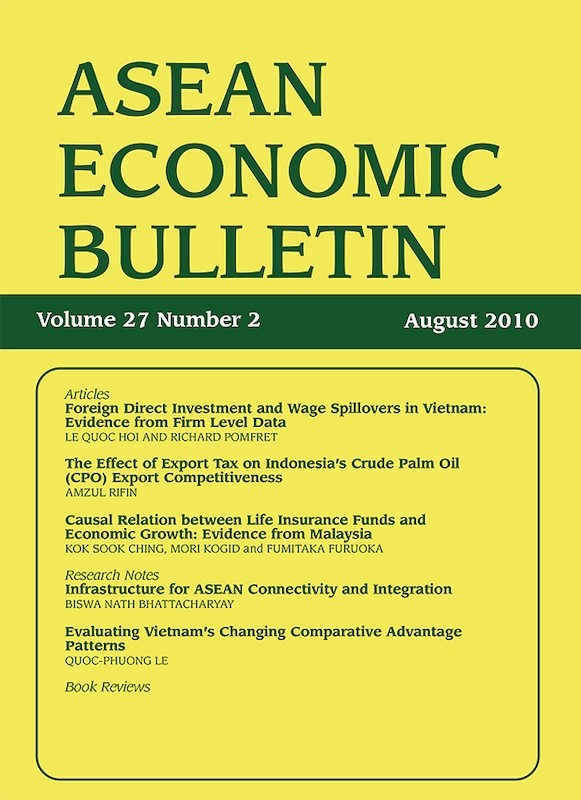
Date of publication:
August 2010
Publisher:
Institute of Southeast Asian Studies
Number of pages:
85
Code:
AE27/2
Contents
-
ASEAN Economic Bulletin Vol. 27/2 (Aug 2010)
[Whole Publication] -
Preliminary pages
- ARTICLES
-
Foreign Direct Investment and Wage Spillovers in Vietnam: Evidence from Firm Level Data, by Le Quoc Hoi, Richard Pomfret, contributors see abstractThis paper examines the impact of FDI on wages paid by domestic private firms in Vietnam. The existing literature has examined the impact of foreign firms on domestic firms wage levels within an industry. We expand on the literature by examining inter-industry linkages as an additional conduit for wage spillovers. There is strong evidence of horizontal wage spillovers from foreign firms to domestic private firms in Vietnam, despite different labour market conditions and firms characteristics. Vertical wage spillovers exist, but depend on the specific characteristics of firms and industries. A further finding is that training activities facilitate wage spillovers.
-
The Effect of Export Tax on Indonesia's Crude Palm Oil (CPO), by Amzul Rifin, contributor see abstractCrude palm oil (CPO) is one of the main export commodities of Indonesia. Besides an export commodity, it is also an essential raw material in producing cooking oil. In order to secure the availability of domestic CPO, the government of Indonesia imposed an export tax policy in September 2004. The objective of the export tax was to control the price of cooking oil at an affordable rate. The objective of this study is to describe the export tax policy on CPO imposed by the Indonesian government and to analyse the effect of the export tax on Indonesia's CPO export competitiveness compared with Malaysia, the main competitor. An export ratio equation between Indonesia and Malaysia is constructed using monthly data. The dependent variable is CPO export of both countries, meanwhile the independent variables include price ratio, export tax difference, refined palm oil export ratio, and exchange rate ratio. The result shows that Indonesia's export tax policy will cause CPO export competitiveness to decrease.
-
Causal Relation between Life Insurance Funds and Economic Growth Evidence from Malaysia, by Kok Sook Ching, Mori Kogid, Fumitaka Furuoka, authors see abstractThe life insurance sector has been growing rapidly in Malaysia with enlarged pooled funds that allowed the sector to participate actively in portfolio investments. It reflects a possible growth impact, which has not gained much attention from the current research. This study aims to examine the existence of a causal relation between the life insurance sector and the growth of the Malaysian economy. This study applies the Johansen co-integration test, and the Granger causality test based on the Vector Error Correction Model (VECM) to demonstrate the possible causal relation. The results provide sufficient evidence to support a long-run relationship between the life insurance indicator (the total assets of Malaysian life insurance sector) and the real GDP, and also a short-run causal relation from the real GDP to the life insurance indicator (the total assets of Malaysian life insurance sector). The findings suggest that the life insurance sector of Malaysia could potentially be an effective financial intermediation to generate long-term savings to finance capital investments and eventually could strengthen the country's economic growth.
- RESEARCH NOTES
-
Infrastructure for ASEAN Connectivity and Integration, by Biswa N. Bhattacharyay, author
-
Evaluating Vietnam's Changing Comparative Advantage Patterns, by Quoc-Phuong Le, author see abstractThis article provides an empirical analysis of Vietnam's comparative advantage and its changes since the country's reform programme began in 1986. The framework for analysis is the concept of revealed comparative advantage. The findings indicate that despite a rapid shift in comparative advantage structure from primary products towards labour-intensive manufacturing during 199196, and a further slow shift towards technology-intensive manufacturing since then, Vietnam's comparative advantage is still largely based on the country's endowments of labour and natural resources. So far Vietnam has been able to expand its exports mainly by exploring these favourable conditions. However, exports based on such existing comparative advantage do not deliver significant value-added earnings. It is therefore recommended that relevant policy be implemented to move the economy and its export sector towards a desirable comparative advantage structure by: (1) strengthening food-processing and mining-processing industries to increase value-addedness of exports of primary products; (2) building up strong supporting industries to move the manufacturing sector away from outward processing; (3) encouraging investment in technology-intensive industries; and (4) enhancing human capital and raising the technology capacity of firms.
- BOOK REVIEWS
-
BOOK REVIEW: Political Economy In A Globalized World, by Joergen Oerstrm Moeller, by Robert L Curry, Jr., author
-
BOOK REVIEW: Making Poverty a History, by Thomas Lines, by Wishnu Mahraddika, author
-
BOOK REVIEW: New Frontiers in Free Trade: Globalization's Future and Asias Rising Role, by Razeen Sally, by Aekapol Chongvilaivan, author
-
BOOK REVIEW: The Politics of Food Supply: U.S. Agricultural Policy in the World Economy, by Bill Winders., by Sandeep Vaheesan, author

